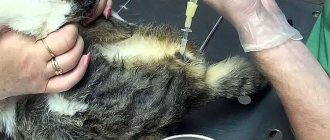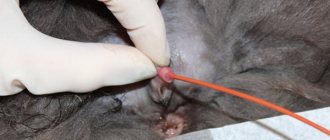7238Pavel
In cases of serious illness, all pets require medical attention. And often it has to be provided at home. If it is necessary to give an animal an IV or remove fluid from the bladder, many owners ask questions about how to place and remove a catheter from a cat.
Thanks to this device, it is possible to avoid constant injections. The catheter allows you to give your pet a drip or injection at any time necessary.
© shutterstock
And in the postoperative period or in case of diseases of the urinary system, this device allows you to empty the animal’s bladder of excess fluid completely painlessly.
What it is?
Catheterization of the bladder in cats is necessary for the treatment of urolithiasis, cystitis and other pathologies of the genitourinary system. The procedure can only be performed by a veterinarian, as a person without special knowledge can cause serious injury to the penis or urethra.
With the help of catheterization, you can introduce the necessary medications into the organ, alleviate the cat’s condition, and also take urine for further research. The event, carried out in a veterinary clinic, is harmless to the animal, since only experienced doctors are allowed to perform it.
Catheter for diseases of the urinary system
If you have problems with urination (oncological diseases, prostate pathologies, urolithiasis, etc.) in a cat or dog, a catheterization procedure is necessary. This is the only way in some cases it is possible to save a pet’s life.
It may be necessary to insert and remove a catheter in the following cases::
- when you need to control your cat's urination;
- in the postoperative period;
- if there are injuries to the genitourinary system;
- to remove stones from the bladder;
- for therapeutic purposes (washing the urinary system);
- for one-time excretion of urine.
© shutterstock
To whom is it assigned?
The main indications for performing the bladder catheterization technique in a cat include:
- Urolithiasis disease.
- Idiopathic cystitis.
- Various obstructions of the urinary canal.
- Collecting urine for analysis.
- Bladder surgeries requiring permanent absence of urine.
- Inflammation of the urethra.
- Disorders in which the pet cannot urinate on its own (paralysis).
Indications and contraindications
The main indications for bladder catheterization in cats:
- Various obstructions of the urinary canal.
- Urolithiasis disease.
- Idiopathic cystitis.
- Inflammation of the urethra.
- Collection of urine analysis.
- Surgeries on the bladder, when a permanent absence of urine in the organ is necessary
- Functional disorders, when the animal cannot urinate on its own (paralysis)
The main contraindications for bladder catheterization in cats:
- Decreased immunity in the presence of various viral diseases.
- Tumors of the bladder and urethra.
- Sepsis.
We suggest you read: How to remove a catheter at home
Catheterization is not recommended in the following situations:
- Sepsis.
- Tumors of the urethra and bladder.
- Decreased immunity.
- Various viral and infectious diseases.
Preparation
As a rule, before starting the procedure, the specialist carries out a number of preparatory measures, which include:
- Research for contraindications and reasons for catheterization. If this procedure is not possible, other methods of removing urine from the organ are chosen as treatment.
- Anesthesia. It is necessary so that the pet does not feel pain during all manipulations. Without pain relief, the cat can harm both itself and the veterinarian. Sedation or general anesthesia is most often used. The first option applies to pets with lack of appetite, severe intoxication, various functional disorders and a prolonged course of the disease. The second option is used in animals whose condition is assessed as satisfactory, without severe intoxication and without heart and vascular diseases. Catheterization of the bladder in cats without anesthesia is carried out only in the case of an extremely serious condition of the animal.
- Hygienic measures. Before the procedure, the hair from and around the penis is shaved, and the skin is disinfected. This is necessary to prevent pathogenic microflora from entering the bladder.
- Additional pain relief. Various local aerosol analgesics are used as local anesthesia. This further reduces sensitivity, since the head of the penis contains many nerve endings. Without analgesia, the cat will feel pain even under anesthesia.
Bladder catheterization in a cat: how to do it
The procedure is carried out as follows:
- A catheter with a mandrel lubricated with lubricant is inserted into the lumen of the urethra. Lubrication is necessary to ensure that the instrument does not damage the walls of the urinary canal.
- If the device encounters various obstructions before entering the bladder, then a special solution is injected through the catheter, destroying the plugs and facilitating its further advancement.
- When the instrument enters the bladder, urine begins to flow out. By smell and color, the veterinarian can determine the condition of the organ and prescribe appropriate therapy. Part of the urine is taken for further testing.
- If there is blood in the urine, we can say that the integrity of the walls of the organ is compromised. In this case, the specialist rinses the bladder with a special solution, most often novocaine, to remove crusts and blood clots that have formed in the organ, as well as to prevent the problem from reoccurring.
- If necessary, the catheter is left in place for several days. This is necessary so that urine is artificially removed from the body. In this case, the pet is prescribed medication and diet therapy to help relieve acute symptoms.
Technique
- A special catheter with a mandrel is inserted into the lumen of the urethra. Before insertion, it is lubricated with a special lubricant so that the instrument does not damage the inflamed walls of the urinary canal.
- If the catheter encounters various obstructions before entering the bladder, then various solutions are injected through the catheter into the urinary canal to break the plug and further advance the instrument to the bladder.
- The fact that the catheter has reached the right place is indicated by the flow of urine from its lumen. Based on the color, smell and condition of the urine, the veterinarian analyzes the condition of the organ and prescribes further treatment. Part of the urine is taken for analysis.
- The presence of blood in the urine indicates that the integrity of the bladder walls is compromised. The veterinarian washes the organ with various solutions, most often a solution of novocaine, to remove blood clots and crusts that have formed in the organ, so that they do not provoke the formation of new urethral obstruction.
- If necessary, a catheter is sutured to the prepuce and left in place for 48 hours to allow urine to be artificially drained from the bladder. In this case, the animal is prescribed diet therapy and drug treatment in order to relieve acute symptoms and after removing the catheter, the animal can urinate on its own.
Care
During bladder catheterization in a cat, the pet is prescribed antibacterial agents to prevent the development of pathogenic microflora in the urethra and bladder. In this case, the owner of the animal must follow all the veterinarian’s recommendations for treatment.
In addition, it is necessary to maintain the sterility of the catheter itself. If it is present for several days, the device should be washed with a special solution recommended by a doctor. You also need to monitor the condition of the fur in the perineal area and keep it clean, and regularly treat the genitals with antibacterial solutions of chlorhexidine or furatsilin. This will prevent the development of infections.
Catheter care rules
The main condition for caring for a urethral catheter in an animal should be compliance with the rules of asepsis and antisepsis. If a permanent urinary apparatus is installed, the owner should maintain its sterility. It is necessary to monitor the condition of the fur in the perineal area, keep it clean, and, if necessary, shave the hair to avoid getting it into the genitourinary tract.
The genital area should be regularly treated with antiseptic solutions of furatsilin or chlorhexidine. This will prevent the development of a bacterial genitourinary infection.
With continuous catheterization for several days, it is necessary to flush the cat's urinary catheter. This procedure is performed to sanitize the urinary tract with a warmed saline or antiseptic solution twice a day. For rinsing, syringes without a needle are used. After removing urine from the catheter, about 60-80 ml of disinfectant liquid is injected with their help.
Empty the bladder using empty syringes for this purpose. Having freed the organ from fluid, add another 60-80 ml of solution, close the catheter with a lid and leave for sanitation. After 20 minutes, the system is opened and the flushing liquid is removed using empty syringes. Carry out the procedure until the flowing solution becomes transparent. As a rule, 2–3 such manipulations are required.
If installation of a permanent urethral catheter is necessary, then experts, as a rule, recommend that owners leave the animal in the clinic’s hospital for bladder lavage.
An indwelling urinary catheter is a flexible plastic tube that is inserted through the opening of the urethra to drain urine. The instrument is held in place by a small balloon, and prolonged catheterization is often performed. Only a veterinarian can place the tube correctly.
Home care:
- Check the area around the urethra for inflammation or signs of infection, such as irritated, swollen skin where the tube was inserted.
- The drainage bag should be placed below the level of the bladder.
- Clean the area around the drainage tube twice a day.
- The catheter and drainage tube should not be bent.
- The product must not be left open.
- Empty the liquid collection bag promptly.
- In case of contamination, rinse the device with warm boiled water.
The connection of the catheter to the sterile drainage system creates a closed system that cannot be opened. Antibacterial drugs will help to avoid infection by reducing the likelihood of developing an infection. Improper removal of the medical device may result in injury to the animal's excretory system. To avoid this, you need to know how to remove a cat's catheter.
Bladder catheterization in a cat: consequences
After this treatment procedure, your pet may experience various complications, which include:
- Lack of diuresis. Due to the fact that the urethral muscles are in spasm, the pet cannot go to the toilet. To eliminate the pathology and relieve unpleasant symptoms, the animal is prescribed antispasmodics.
- Urethral injuries. Can occur if the specialist is inexperienced. In such a situation, the cat must be taken to the veterinarian again. The injuries are characterized by severe pain in the urethral area, the cat licks the sore spot and cannot urinate normally. Sometimes there may be blood in the urine.
- The cat often licks itself after bladder catheterization. This may be due to unpleasant sensations after the procedure, which will accompany the pet for some time, or due to the presence of injuries.











